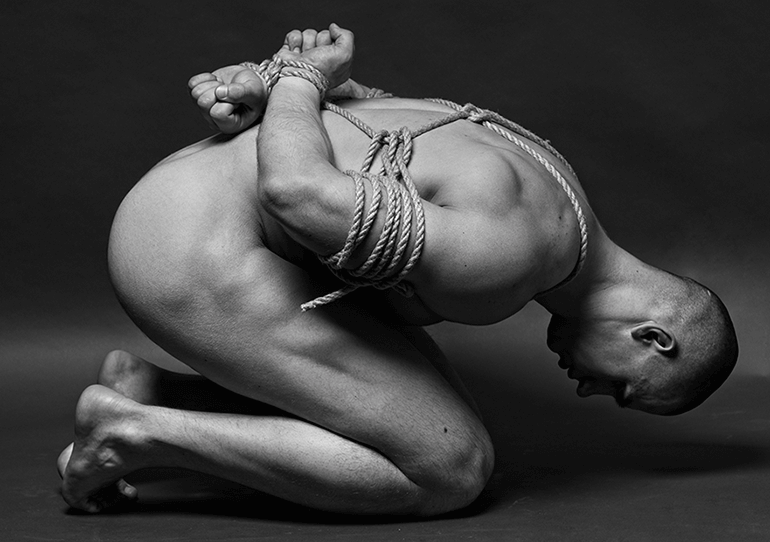
In the realm of power dynamics, rope serves a dual purpose as both an artistic medium and a practical restraint tool. Whether used for the intricate beauty of Shibari or the straightforward functionality of traditional restraint, rope offers a unique blend of aesthetics and purpose.
Rope bondage has transcended its origins to become an art form in its own right. Its strong ties to the fetish community place it at the intersection of art and desire, where the choice of rope, knots, and even lengths can ignite passionate debate among enthusiasts and purists.
“Whether used as a tool of restraint or as an artist’s canvas, rope becomes an extension of the dominant’s will and personality.”
While the sight of an experienced rigger suspending someone from a ring might mystify, intrigue, and captivate an audience, for many of us, rope is simply a tool for restraint or an occasional object of beauty. A simple Karada or Shibari chest harness can look stunning, but mastering these techniques demands time and dedication.
In its loose form, rope appears innocuous, but once tied, it takes on a life of its own. Whether used as a tool of restraint or as an artist’s canvas, rope becomes an extension of the dominant’s will and personality. It’s a deeply personal tool, showcasing creativity, expertise, or simply a desire to restrain as efficiently as possible. Versatile, affordable, and essential, rope is a staple in any tool kit.

Shibari The Art of Japanese Rope Bondage
Shibari, also known as Kinbaku, is a traditional Japanese art form that dates back centuries. Originally used in feudal Japan as a method of restraint for prisoners, it has since evolved into a sophisticated form of erotic art. Shibari’s intricate patterns and meticulous attention to detail reflect a deep cultural heritage, transforming rope bondage into a visually stunning and emotionally charged practice.
In Shibari, the beauty of the rope is as important as its function. The intricate designs and patterns not only enhance the visual appeal but also bring about a profound emotional connection between the individuals involved. The process of tying and being tied can evoke a range of emotions, from vulnerability to trust, creating a rich tapestry of experience that goes beyond mere restraint.

Traditional Restraint Rope: Functionality and Practicality
Traditional restraint ropes are valued for their simplicity and effectiveness. Unlike shibari, which prioritizes artistry, these ropes are chosen for their durability and ease of use. Their primary purpose is straightforward: to restrain and control. In a power exchange dynamic, the practical application of restraint ropes ensures that boundaries are respected and roles are clearly defined, providing a solid foundation for the scene.
The sensory experience of traditional restraint ropes can vary widely depending on the material used. From the coarse texture of jute to the smooth feel of cotton, each type of rope offers a distinct tactile experience. For the rigger, handling the rope involves a tactile and rhythmic connection, while for the tied partner, the sensation of the rope against the skin can range from comforting to stimulating, influencing the overall dynamic of the scene.

Building Trust and Communication
Regardless of whether shibari or traditional restraint rope is used, trust and communication are paramount in any power exchange dynamic. Clear communication ensures that boundaries are respected and that both parties are comfortable with the scene. Building trust through careful negotiation and mutual respect enhances the experience, allowing the participants to fully engage with the physical and emotional aspects of rope bondage.

Conclusion
Rope bondage can evoke a range of sensations: arousing, painful, comforting, or even meditative. After being released, one might feel faint or experience a form of sub-drop, highlighting the profound vulnerability in both being tied and the moment of release, while rope marks left on the skin are often cherished.
Straps, cuffs, and chains have their appeal, but they lack the personal touch that rope provides. There’s something undeniably beautiful about having your wrists or body bound by a Dominant, whether their intent is sadistic, artistic, or simply to restrain you efficiently.
The experience of rope also involves an interplay of pleasure and pain. Some ropes self-tighten and each rigger has a distinctive style, some more painful than others, while the more demanding positions can cause stress.
Though I lack the experience of binding and tying with rope, I’m eager to understand from those who do. If you’re willing to share, I’d love to hear about your experiences as a Dominant. What is it like for you to use rope in this way? What motivates you, and what purpose does it serve in your practice?















As a dominant, one of the things I like about rope is that you can use it to express yourself and create trust. As you say, there’s a real intimacy during the process of tying. The sub is beginning to feel ‘held’, and the time taken to tie allows both parties to relax into their roles. On early meetings, demonstrating competence by tying confidently (and well!) will reassure the sub, and communication as you tie (such as “you’ll feel this tighten around your arms now”) helps build the trust that the dominant is looking after the submissive. As it comes afterwards, people often don’t think so much about the process of untying, but as you point out, a sudden release can contribute to sub-drop and may also be embarrassing for the dominant as their ropes fall into a tangle just at the moment the submissive needs their care. Being just as methodical during untying as during tying, paying attention to keeping an even (and reassuring) tension as you progress, gives a more satisfying experience for both parties.
Thank you for such an insightful comment. I completely agree, untying can be just as intense, if not more so, than the act of tying itself. As you mentioned, the release serves as a reminder of the restraint, often requiring a quicker adjustment, yet still carrying its own emotional weight.
There’s something undeniably seductive about a dominant who truly understands the ropes, one who guides the experience with care and precision, turning it into a collaboration rather than a purely self-serving act.
Interestingly, despite the inherent vulnerability in being tied, I often feel even more exposed once I’m untied, as if the removal of the physical bonds heightens the emotional openness.
Thank you again for sharing your thoughts.